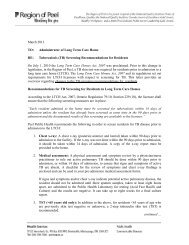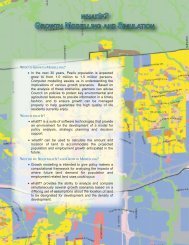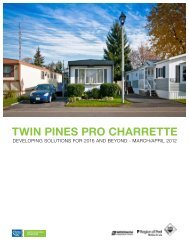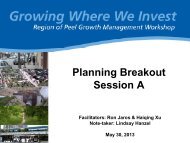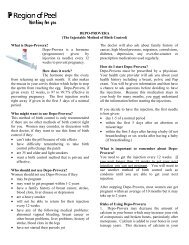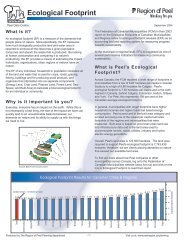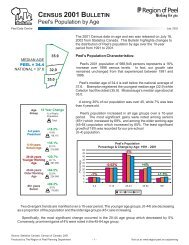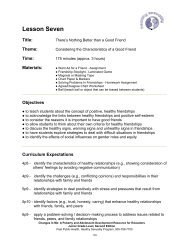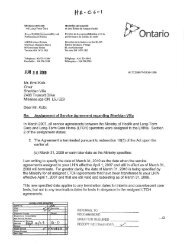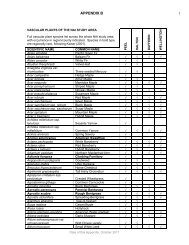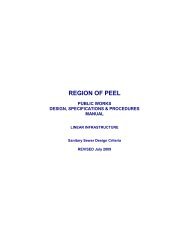FIFTH LINE – 22 SIDEROAD (LIMEHOUSE CA ... - Region of Peel
FIFTH LINE – 22 SIDEROAD (LIMEHOUSE CA ... - Region of Peel
FIFTH LINE – 22 SIDEROAD (LIMEHOUSE CA ... - Region of Peel
You also want an ePaper? Increase the reach of your titles
YUMPU automatically turns print PDFs into web optimized ePapers that Google loves.
<strong>FIFTH</strong> <strong>LINE</strong> <strong>–</strong> <strong>22</strong> <strong>SIDEROAD</strong><br />
(<strong>LIMEHOUSE</strong> <strong>CA</strong> AND AREA)<br />
Physical Features<br />
This area is in the Niagara Escarpment physiographic region; characterized by an escarpment that<br />
forms a significant break in the bedrock <strong>of</strong> the region. The escarpment has formed from the differing<br />
erosion rates <strong>of</strong> the bedrock layers, the s<strong>of</strong>ter lower shale layers eroding out from under the hard<br />
dolostone cap rock until portions <strong>of</strong> the cap rock collapse to form a cliff face and talus slope.<br />
There is cliff face and talus slope within the Limehouse Conservation Area part <strong>of</strong> this site. Crevices<br />
are present for a short distance back from the rock face. This area is well-known for Hole-in-the-Wall,<br />
a spot where the Bruce Trail drops down a crevice and between large cliff blocks via a ladder,<br />
exemplifying the escarpment geology <strong>of</strong> the area. The railway cut along the northern border <strong>of</strong> this<br />
site has good exposures <strong>of</strong> Silurian bedrock and is a locally significant earth science Area <strong>of</strong> Scientific<br />
and Natural Interest (ANSI) (Natural Heritage Information Centre, 2010; North-South Environmental,<br />
2004).<br />
Black Creek flows east through this natural area and then turns south at the point where it is joined by<br />
Beeney Creek, a small tributary <strong>of</strong> Black Creek.<br />
Human History<br />
The nearby community <strong>of</strong> Limehouse was first settled in 1820. By the 1840’s limestone quarrying and<br />
“burning” <strong>of</strong> limestone in kilns to make lime, had begun. The Grand Trunk Railway built its line<br />
through Limehouse in 1856 which required 200 workers and their families to settle in the area. Many<br />
<strong>of</strong> these families stayed in the community after the rail line was completed. Besides the lime industry,<br />
there was also a woollen mill, sawmill and a paint factory (using coloured clay from the area) (Gibson,<br />
Undated; Lewis, 2010; McIlveen, 2006).<br />
Parts <strong>of</strong> this natural area were cleared for logging and agricultural purposes. Some <strong>of</strong> the land may<br />
have been grazed.<br />
The lime kilns provided mortar for local buildings from the 1840’s until about 1915. At this time, a<br />
dammed mill pond existed along Black Creek in the north-west corner <strong>of</strong> this natural area and<br />
provided water power to lime industry buildings and to a sawmill. The pond has reverted to marshland<br />
when the dam was broken. A railway once bisected the area below the cliffs and the old railbed is<br />
visible. The remains <strong>of</strong> the lime kilns still exist and a local organization has formed to protect and<br />
restore this historic site. In about 1967, CVC acquired approximately 200 acres to be set aside as<br />
Limehouse Conservation Area.<br />
Limehouse Conservation Area occupies almost half <strong>of</strong> this natural area. It is developed for passive<br />
recreations (hiking) on a network <strong>of</strong> hiking trails, <strong>of</strong> which the Bruce Trail is a part. The conservation<br />
area receives moderate-high use as a section <strong>of</strong> the Bruce Trail and the lime kilns are popular<br />
attractions.<br />
This area is bordered by Fifth Line on the west side, by a railway line to the north and a narrow part<br />
along Black Creek extends to Sixth Line where the creek crosses under the road. Surrounding land<br />
use is agricultural, regenerating old fields, rural residences and recreational manicured area with two<br />
baseball diamonds.<br />
Vegetation Communities<br />
The general community types present are open rock barren (



